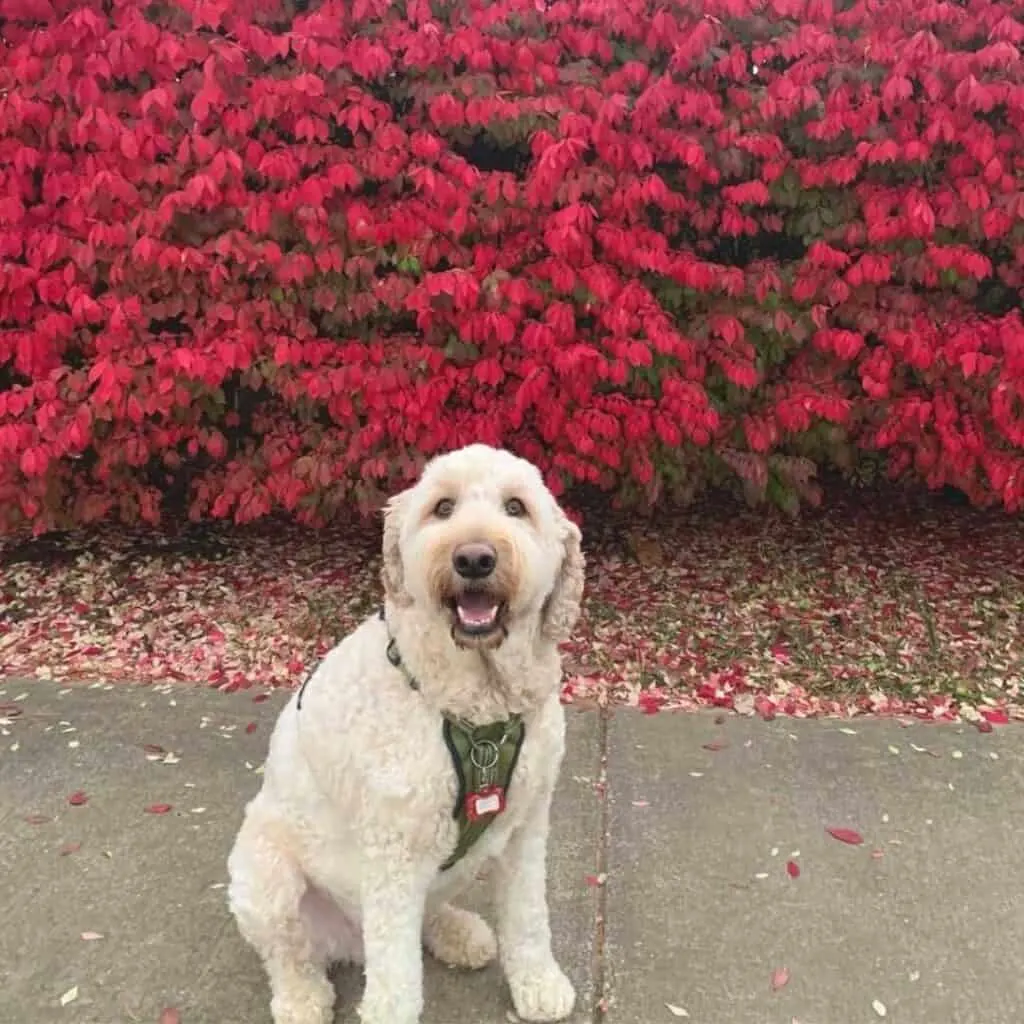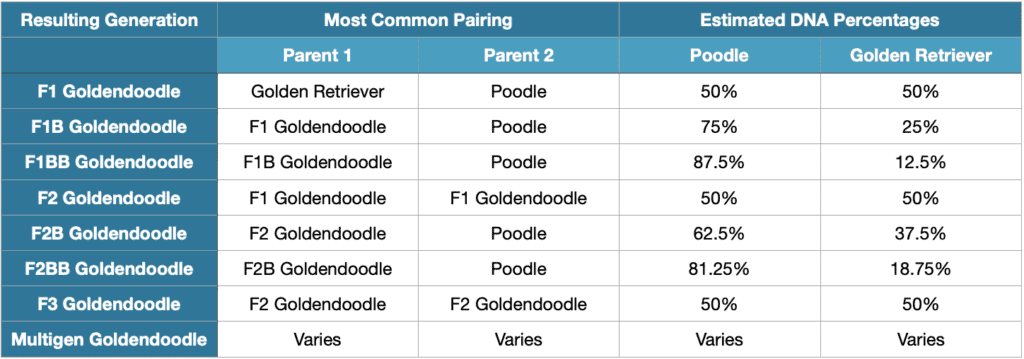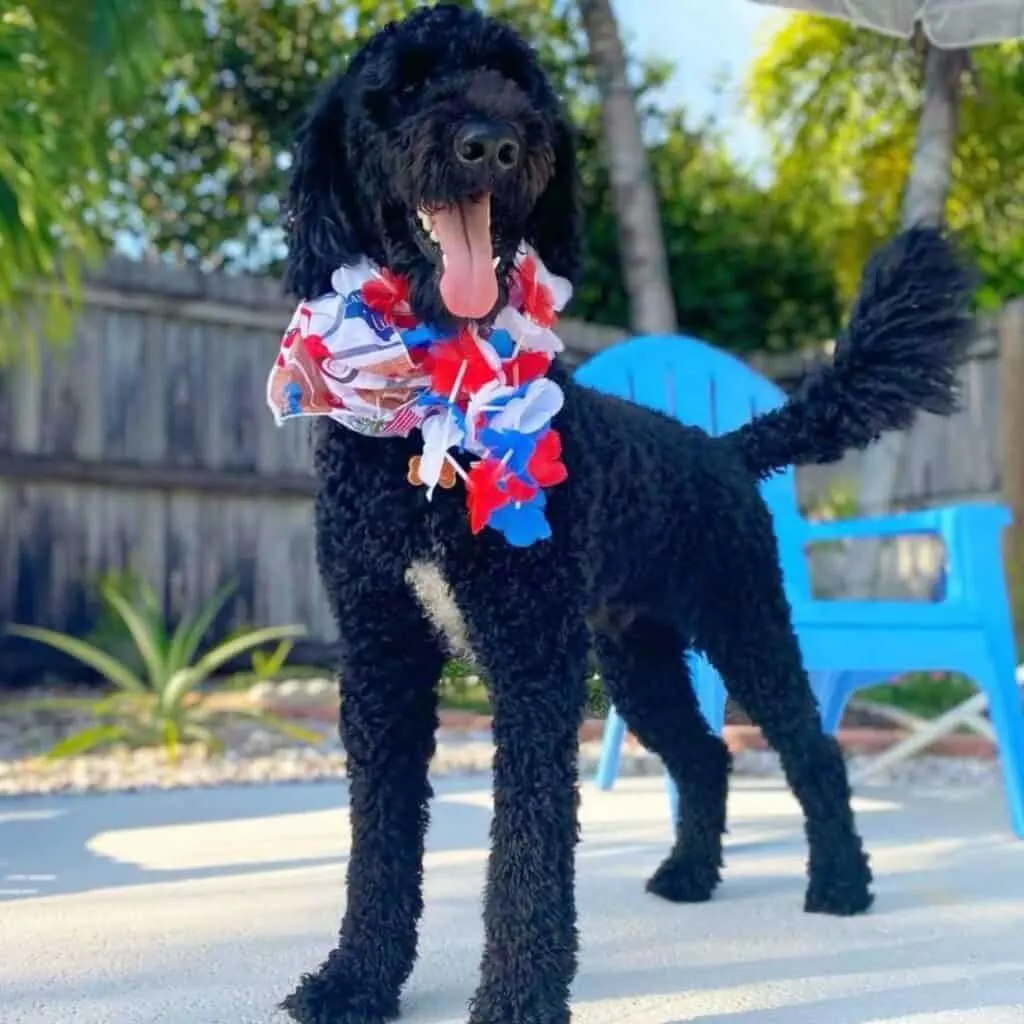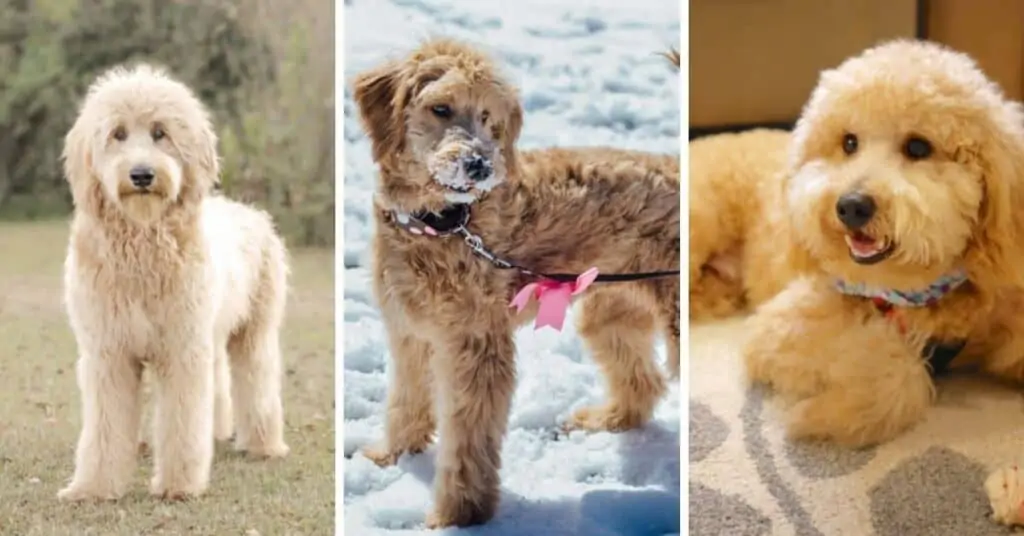
Before bringing home an English Cream “Teddybear” Goldendoodle, you may have a lot of questions on your mind.
What’s the difference between an English Goldendoodle and a “regular” Goldendoodle? Why are they sometimes called Teddybear Goldendoodles? Most importantly, is this type of Goldendoodle a good fit for my family?
Let’s delve deep into this new hybrid dog, dispelling the myths and getting a real understanding of who they are. Read on to learn more about the English Cream Teddybear Goldendoodle—an up and coming canine superstar!
What is an English Goldendoodle?
An English Goldendoodle is a cross between an English Cream Golden Retriever and a Poodle. This variation of the Goldendoodle is sometimes referred to as a “Teddybear Goldendoodle” thanks to its broader head which loosely resembles that of a stuffed animal.
Whether or not Goldendoodle puppies are classified as English Goldendoodles depends on the Golden Retriever parent used for breeding. While there is just one Golden Retriever breed recognized by all kennel clubs, this breed comes in three varieties—English, American, and Canadian.
All Golden Retrievers can trace their heritage back to Scotland, when they were first established in the middle of the 1800s. While American Goldens are seen mostly in the USA, the English Cream Golden Retriever is popular in Europe and Australia.

English Goldendoodle vs American Goldendoodle
English Cream Goldendoodles, aka Teddybear Goldendoodles, are not the same as American Goldendoodles. Since they are bred from English Golden Retrievers rather than American Golden Retrievers, they are somewhat different in both personality and appearance.
You will find that the American Goldendoodle is available in a much larger number of colors, from apricot to black to a darker red. There are even multi-colored patterns available like Tuxedo, Parti, and Phantom.
Read More: 13 Incredible Goldendoodle Colors You Never Knew Existed!
The English Cream Goldendoodle, as the name implies, is most often a light cream color as this is a shade that tends to dominate genetically.
English Goldendoodles have broader skulls and are tend to be stockier and heavier than their American counterparts who tend to be slimmer and more athletic. This unique head shape is what gives them the moniker, “Teddybear Goldendoodles.”
Of course, this isn’t an excuse to have a portly English Goldendoodle! Even these larger dogs are naturally supposed to be lean.
Personality wise, English Goldendoodles are less energetic and more laid back. They can be easier to train and may mature faster than American Goldendoodles.
Importantly, these varieties of Goldendoodles share lots of similarities. They are both adorable, fun-loving dogs who are affectionate and form strong bonds with their families.
Simply put, they are far more similar than they are different!
How Do You Get a Teddybear Goldendoodle?
The terms, “Teddybear Goldendoodle,” “English Goldendoodle,” and “English Cream Goldendoodle” all refer to the exact same type of dog. These are just different ways to describe the pairing of an English Golden Retriever and a Poodle.

What Types of Teddybear Goldendoodles Are There?
Teddybear Goldendoodles can come in a number of types or “generations.” These generations describe how much DNA your dog shares with a purebred English Golden Retriever and a purebred Poodle.
While generations can be a bit tricky to wrap your mind around at first, the system is logical and is one you will get used to with a little time.
We call the puppies from the first crossing of a purebred Poodle and a purebred English Golden Retriever “F1 English Goldendoodles.”
If one of these F1 puppies is later bred to a purebred Poodle, their litter would be classified as “F1B English Goldendoodles.” While closely related, there are differences between the F1B generation and the F1 generation. Most notably, an F1B Goldendoodle’s odds of shedding are greatly decreased thanks to their larger proportion of Poodle DNA.
If we delve a little deeper, the F1BB English Goldendoodle generation is when an F1B English Goldendoodle is bred back to the Poodle once again. These dogs have a large amount of Poodle DNA and are often the generation most recommended for allergy sufferers.
An F2 English Goldendoodle is most often the result of an F1 being bred with another F1. Typically these dogs are not as suited for allergy sufferers and can often possess more Retriever characteristics. F2 Teddybear Goldendoodles have a reputation for being somewhat unpredictable genetically.
If we look a little further down the wormhole, we will stumble across F3 Teddybear Goldendoodles. These dogs are the most unpredictable of all as we cannot know with certainty which genes they will inherit from which purebred ancestor.
While these are the most common types of Teddybear Goldendoodles, generations can get even more obscure and complex. See the table below for a handy reference on different generations and their estimated genetic makeups.
If you want to learn all about the pros and cons of each Goldendoodle generation, we have an article that goes into even more detail!

English Goldendoodle Colors
The English Teddybear Goldendoodle is usually a light cream or golden color. This is why they’re often called English Cream Goldendoodles.
However, much like American Goldendoodles, they can come in a much wider array of coat colors including apricot, chocolate, cream, brown, and black.
Remember, just because an Goldendoodle is cream, doesn’t make it an English Cream Goldendoodle. There are American Goldendoodles that are cream colored as well.
On the other side of the coin, just because a Goldendoodle isn’t cream doesn’t mean it’s not an English Cream Goldendoodle. While more rare, there are English Cream Goldendoodles in different colors.

How Big Do English Goldendoodles Get?
From the shoulders to the ground, the standard English Goldendoodle will measure from 19 inches to 25 inches. They will weigh roughly 50 to 85 pounds.
Of course, as they are not pedigree dogs with strict breed standards, it would not be unheard of for some individuals to fall outside of this range.
If a toy or miniature Poodle is used in breeding, the resulting puppies will be significantly smaller. In these breedings, the mother dog must always be the bigger one.
Expect Mini English Goldendoodles to range in height from 13 to 20 inches and in weight from 15 to 50 pounds. Mini Teddybear Goldendoodles can be a great option for those who love this breed, but need it in a “smaller package.”
Read More: Goldendoodle Size Full Grown: How Big Do Goldendoodles Get? (Teacup, Toy, Mini, Medium, Standard)
In general, while English Goldendoodles are usually heavier and stockier than American Goldendoodles, they are generally the same height.
How Much Does an English Goldendoodle Cost?
On average, you can usually expect to pay between $2,200 and $4,800 for an English Goldendoodle puppy. Since they are a more rare variation of this breed, they tend to cost more than the average Goldendoodle.
Prices can vary considerably depending on the current economic climate, consumer demand, and where you are in the world. Additionally, the cost of a Teddybear Goldendoodle also depends on which generation you are buying and if you want a male or female.
Related: Male vs Female Goldendoodle: Which is Right for You?
As the buyer, it is up to you to ensure you are purchasing from a reputable source and not a puppy mill. Where possible, you should try to buy puppies whose parents have been health tested, especially for Hip Dysplasia.
Related: Goldendoodle Health Issues: 10 Common Goldendoodle Health Problems to Look Out For!
While these pups may cost more, this is the most ethically sound decision and can save you money and heartache in the long run.
Additionally, investing in a quality pet insurance plan can help you save money on unexpected veterinary bills over the course of your Goldendoodle’s lifespan. Healthy Paws is one reputable option that many Goldendoodle owners swear by!
Are Teddybear Goldendoodles Hypoallergenic?
Teddybear Goldendoodles are NOT guaranteed to be hypoallergenic. Some English Goldendoodles will be allergy-friendly, while others may not.
Whether or not a Teddybear Goldendoodle is hypoallergenic will depend on the genes it has inherited. Generations such as the F1BB and F1B tend to be more allergy-friendly than the F2 or F3 generations.
It is important to emphasize that some allergy sufferers react to all dogs—including those labeled as hypoallergenic.
Read More: Are Goldendoodles Hypoallergenic? (We Asked 76 Allergy Sufferers!)

Do English Goldendoodles Shed?
English Goldendoodles generally do not shed much and are not a ‘smelly’ breed.
While all dogs shed to some degree, the small amount of fur that English Goldendoodles lose is typically trapped under their curly coat and removed easily when brushing. This means you won’t normally see lots of loose hair around your home.
If you regularly brush and bathe our Goldendoodle, you’ll find that they usually don’t shed that much. However, a small amount of fur loss is only natural.
Read More: Do Goldendoodles Shed? The TRUTH About Goldendoodle Shedding
Are English Cream Goldendoodles Hyper?
On average, English Cream Goldendoodles tend to be more laid back than American Goldendoodles. However, there is no doubt that all Goldendoodles, the English variety included, can be high-energy, fun-loving dogs.
Whether or not the Teddybear Goldendoodle would be classified as “hyper,” largely depends on their environment and lifestyle.
Typically, if their energy needs are met and they are provided with ample mental and physical stimulation, they should not act out or become destructive. However, if we under-exercise them, if they become bored, or if they develop anxiety, they are likely to cause havoc.
Pent up energy can be released in the form of excessive barking, running about aimlessly, tail chasing, yard digging, and furniture chewing.
Keep on top of things by providing at least 90-120 minutes of interesting exercise every day and challenging your English Goldendoodle mentally. This may mean having mini training sessions throughout the day, playing “find the treat,” using a snuffle ball, and offering an array of interactive toys.
If your dog needs additional enrichment activities to keep them mentally stimulated, check out this Brain Training for Dogs program!
Read More About Goldendoodles…

Dr. Linda Simon
Contributing Professional
Dr. Linda Simon is a small animal veterinary surgeon who works as a locum vet in the UK. She qualified in 2013 from UCD, Ireland and was top of her year in small animal medicine. Linda writes for a range of animal-related publications and is the resident vet for Pooch & Mutt dog food. She is a proud doodle owner who shares her life with a 3 year old Cavapoo named Raffie!









